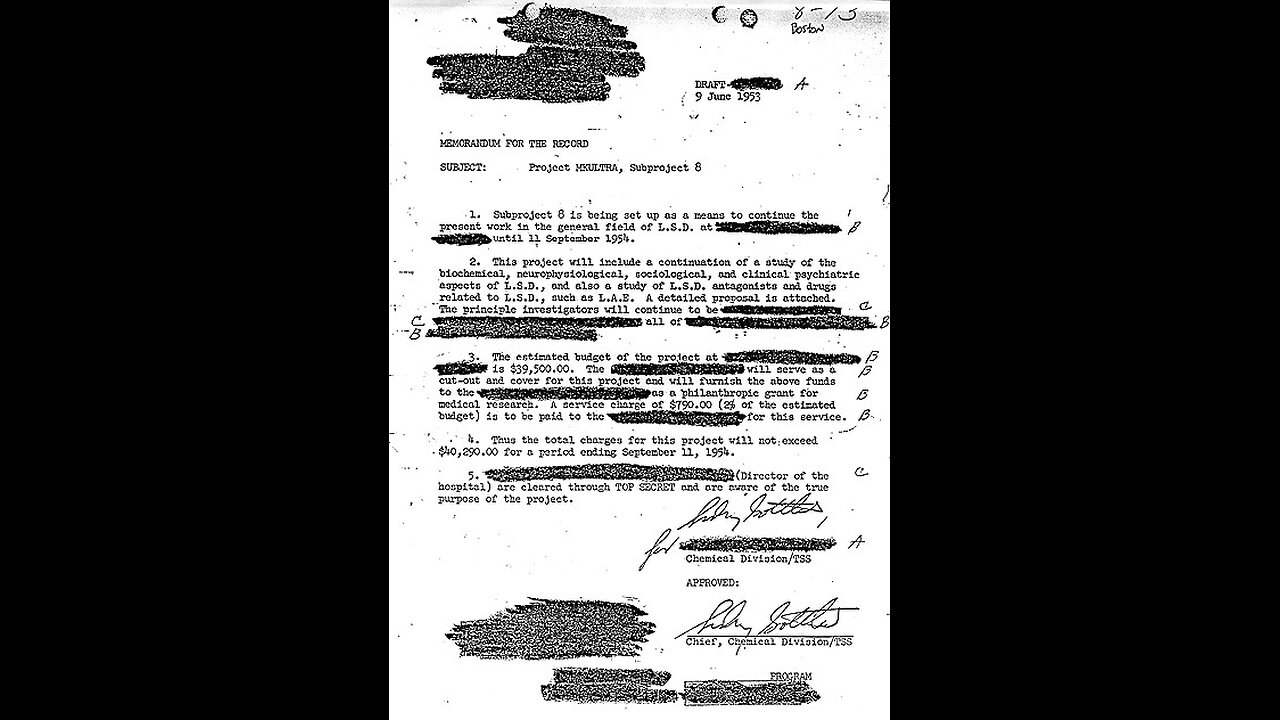Premium Only Content

Medical Experiments on Veterans (2008)
From 1948 to 1975, the U.S. Army Chemical Corps conducted classified human subject research at the Edgewood Arsenal facility in Maryland. The purpose was to evaluate the impact of low-dose chemical warfare agents on military personnel and to test protective clothing, pharmaceuticals, and vaccines. A small portion of these studies were directed at psychochemical warfare and grouped under the prosaic title of the "Medical Research Volunteer Program" (1956–1975). The MRVP was also driven by intelligence requirements and the need for new and more effective interrogation techniques.
Overall, about 7,000 soldiers took part in these experiments that involved exposures to more than 250 different chemicals, according to the Department of Defense (DoD). Some of the volunteers exhibited symptoms at the time of exposure to these agents but long-term follow-up was not planned as part of the DoD studies.[1] The experiments were abruptly terminated by the Army in late 1975 amidst an atmosphere of scandal and recrimination as lawmakers accused researchers of questionable ethics. Many official government reports and civilian lawsuits followed in the wake of the controversy.
The chemical agents tested on volunteers included chemical warfare agents and other related agents:[1]
Anticholinesterase nerve agents (VX, sarin) and common organophosphorus (OP) and carbamate pesticides
Mustard agents
Nerve agent antidotes including atropine and scopolamine
Nerve agent reactivators, e.g. the common OP antidote 2-PAM chloride
Psychoactive agents including LSD, PCP, cannabinoids, and BZ
Irritants and riot control agents
Alcohol and caffeine
History
Background and rationale
After World War II, U.S. military researchers obtained formulas for the three nerve gases developed by the Nazis—tabun, soman, and sarin—and conducted studies on them at the US Army Edgewood Chemical Biological Center. These studies included a secret human subjects component at least as early as 1948, when "psychological reactions" were documented in Edgewood technicians. Initially, such studies focused solely on the lethality of the gases and its treatment and prevention. A classified report entitled "Psychochemical Warfare: A New Concept of War" was produced in 1949 by Luther Wilson Greene, Technical Director of the Chemical and Radiological Laboratories at Edgewood. Greene called for a search for novel psychoactive compounds that would create the same debilitating mental side effects as those produced by nerve gases, but without their lethal effect. In his words,
Throughout recorded history, wars have been characterized by death, human misery, and the destruction of property; each major conflict being more catastrophic than the one preceding it ... I am convinced that it is possible, by means of the techniques of psychochemical warfare, to conquer an enemy without the wholesale killing of his people or the mass destruction of his property.[2]
In the late 1940s and early '50s, the U.S. Army worked with Harvard anesthesiologist Henry K. Beecher at its interrogation center at Camp King in Germany on the use of psychoactive compounds (mescaline, LSD), including human subject experiments and the debriefing of former Nazi physicians and scientists who had worked along similar lines before the end of the war.[3] In the 1950s, some officials in the U.S. Department of Defense publicly asserted that many "forms of chemical and allied warfare as more 'humane' than existing weapons. For example, certain types of 'psychochemicals' would make it possible to paralyze temporarily entire population centers without damage to homes and other structures."[4] Soviet advances in the same field were cited as a special incentive giving impetus to research efforts in this area, according to testimony by Maj. Gen. Marshall Stubbs, the Army's chief chemical officer.
General William M. Creasy, former chief chemical officer, U.S. Army, testified to the U.S. House of Representatives in 1959 that "provided sufficient emphasis is put behind it, I think the future lies in the psychochemicals."[5] This was alarming enough to a Harvard psychiatrist, E. James Lieberman, that he published an article entitled "Psychochemicals as Weapons" in The Bulletin of the Atomic Scientists in 1962. Lieberman, while acknowledging that "most of the military data" on the research ongoing at the Army Chemical Center was "secret and unpublished", asserted that "There are moral imponderables, such as whether insanity, temporary or permanent, is a more 'humane' military threat than the usual afflictions of war."[6]
The experiments
The Edgewood Arsenal human experiments took place from approximately 1948 to 1975 at the Medical Research Laboratories—which is now known as the U.S. Army Medical Research Institute of Chemical Defense (USAMRICD)—at the Edgewood Area, Aberdeen Proving Ground, Maryland. The experiments involved at least 254 chemical substances, but focused mainly on midspectrum incapacitants, such as LSD, THC derivatives, benzodiazepines, and BZ. Around 7,000 US military personnel and 1,000 civilians were test subjects over almost three decades.[7][8][9] A concrete result of these experiments was that BZ was weaponized, although never deployed.[10]
According to a DOD FAQ, the Edgewood Arsenal experiments involved the following "rough breakout of volunteer hours against various experimental categories":[11]
Experimental category Percentage of volunteer hours
Incapacitating compounds 29.9%
Lethal compounds 14.5%
Riot control compounds 14.2%
Protective equipment and clothing 13.2%
Development evaluation and test procedures 12.5%
Effects of drugs and environmental stress on human physiological mechanisms 6.4%
Human factors tests (ability to follow instructions) 2.1%
Other (visual studies, sleep deprivation, etc.) 7.2%
An "Independent Study Course" for continuing medical education produced by the US Department of Veterans Affairs, Health Effects from Chemical, Biological, and Radiological Weapons (October 2003),[12] presents the following summary of the Edgewood Arsenal experiments:
Renewed interest led to renewed human testing by the Department of Defense (DoD), although ultimately on a much smaller scale. Thus, between 1950 and 1975, about 6,720 soldiers took part in experiments involving exposures to 254 different chemicals, conducted at U.S. Army Laboratories at Edgewood Arsenal, MD (NRC 1982, NRC 1984, NAS 1993). Congressional hearings into these experiments in 1974 and 1975 resulted in disclosures, notification of subjects as to the nature of their chemical exposures, and ultimately to compensation for a few families of subjects who had died during the experiments (NAS 1993).
These experiments were conducted primarily to learn how various agents would affect humans (NRC 1982). Other agencies including the CIA and the Special Operations Division of the Department of the Army were also reportedly involved in these studies (NAS 1993). Only a small number of all the experiments done during this period involved mustard agents or Lewisite. Records indicate that between 1955 and 1965, of the 6,720 soldiers tested, only 147 human subjects underwent exposure to mustard agent at Edgewood (NRC 1982).
According to the 1984 NRC review, human experiments at DoD's Edgewood Arsenal involved about 1,500 subjects who were experimentally exposed to irritant and blister agents including:
lachrymatory agents, e.g., CN;
riot control agents, e.g., CS;
chloropicrin (PS);
diphenylaminochlorarsine (DM, Adamsite);
other ocular and respiratory irritants; and
mustard agents.
For example, from 1958 to 1973 at least 1,366 human subjects underwent experimental exposure specifically with the riot-control agent CS at Edgewood Arsenal (NRC 1984). Of those involved in the experiments:
1,073 subjects were exposed to aerosolized CS;
180 subjects were exposed dermally;
82 subjects had both skin applications and aerosol exposures; and finally
31 subjects experienced ocular exposure via direct CS application to their eyes.
Most of these experiments involved tests of protective equipment and of subjects' ability to perform military tasks during exposure.
Similarly, cholinesterase reactivators antidotes such as 2-PAM were tested on about 750 subjects. These agents are still used today as antidotes to organophosphorus nerve agent poisoning, including accidental poisoning by organophosphorus pesticides. About 260 subjects were experimentally exposed to various psychochemicals including phencyclidine (PCP), and 10 related synthetic analogs of the active ingredient of cannabis (NRC 1984). The NRC report also mentions human experiments involving exposure of 741 soldiers to LSD (NRC 1984). Finally, from 1962 to 1972, a total of 123 irritant chemicals were tested on only two subjects each exposed using a wind tunnel (NRC 1984). These irritant chemicals were selected for human testing following preliminary animal studies.
The "Independent Study Course" cites mainly a three-volume study by the Institute of Medicine (1982–1985) for its data and conclusions, Possible Long-Term Health Effects of Short-Term Exposure to Chemical Agents.[13] Some additional information in the section cited from the Course was based on a 1993 IOM study, Veterans at Risk: Health Effects of Mustard Gas and Lewisite.[14]
A significant omission from the Course summary above is the number of subjects on which BZ and related compounds were tested. According to the memoirs of James Ketchum, who also cites the IOM study for the data, "24 belladonnoid glycolates and related compounds" were "given to 1,800 subjects". The IOM study also concluded that "available data suggest that long-term toxic effects and/or delayed sequellae are unlikely" for this type of compound.[15]
In the mid-1970s, in the wake of many health claims made regarding exposure to the agents, the U.S. Congress began investigations of possible abuse in experiments and of inadequate informed consent given to the soldiers and civilians involved.
Scandal and termination
In September 1975, the Medical Research Volunteer Program was discontinued and all resident volunteers were removed from the Edgewood installation. The founder and director of the program, Van Murray Sim, was called before Congress and chastised by outraged lawmakers, who questioned the absence of follow-up care for the human volunteers. An Army investigation subsequently found no evidence of serious injuries or deaths associated with the MRVP, but deplored both the recruiting process and the informed consent approach, which they characterized as "suggest[ing] possible coercion".
Aftermath
Government reports
1982-85 IOM report
The Institute of Medicine (IOM) published a three-volume report on the Edgewood research in 1982–1985, Possible Long-Term Health Effects of Short-Term Exposure to Chemical Agents.[16]
The three volumes were:
Vol. 1, "Anticholinesterases and Anticholinergics" (1982).
Vol. 2, "Cholinesterase Reactivators, Psychochemicals and Irritants and Vesicants" (1984)
Vol. 3, "Final Report: Current Health Status of Test Subjects" (1985)
The National Academy of Sciences, which oversees the IOM, sent a questionnaire to all of the former volunteers that could be located, approximately 60% of the total. The lack of a detailed record hampered the investigation. The study could not rule out long-term health effects related to exposure to the nerve agents. It concluded that "Whether the subjects at Edgewood incurred these changes [depression, cognitive deficits, tendency to suicide] and to what extent they might now show these effects are not known". With regard specifically to BZ and related compounds, the IOM study concluded that "available data suggest that long-term toxic effects and/or delayed sequellae are unlikely".
2004 GAO report
A Government Accounting Office report of May 2004, Chemical and Biological Defense: DOD Needs to Continue to Collect and Provide Information on Tests and Potentially Exposed Personnel (pp. 1, 24), stated:
[In 1993 and 1994] we [...] reported that the Army Chemical Corps conducted a classified medical research program for developing incapacitating agents. This program involved testing nerve agents, nerve agent antidotes, psycho chemicals, and irritants. The chemicals were given to volunteer service members at Edgewood Arsenal, Maryland; Dugway Proving Ground, Utah; and Forts Benning, Bragg, and McClellan. In total, Army documents identified 7,120 Army and Air Force personnel who participated in these tests. Further, GAO concluded that precise information on the scope and the magnitude of tests involving human subjects was not available, and the exact number of human subjects might never be known.[17]
Safety debates
The official position of the Department of Defense, based on the three-volume set of studies by the Institute of Medicine mentioned above, is that they "did not detect any significant long-term health effects on the Edgewood Arsenal volunteers".[9] The safety record of the Edgewood Arsenal experiments was also defended in the memoirs of psychiatrist and retired colonel James Ketchum, a key scientist:[18]
Over a period of 20 years, more than 7,000 volunteers spent an estimated total of 14,000 months at Edgewood Arsenal. To my knowledge, not one of them died or suffered a serious illness or permanent injury. That adds up to 1,167 man-years of survival. Statistically, at least one out of a thousand young soldiers chosen at random might be expected to expire during any one-year period. By this logic, Edgewood was possibly the safest military place in the world to spend two months.
As late as 2014 incomplete information due to the failure to declassify and release relevant classified documents prevented IOM from conducting adequate medical studies related to similar former US biowarfare programs.
The committee's understanding is that additional, and potentially relevant, material on SHAD tests exists and remains classified. The IOM committee requested declassification of 21 additional elements from at least nine documents from DoD in August 2012. In January 2014, an additional request was made for release of multiple films made of Project SHAD tests. None of the requested materials were cleared for public release as of this writing (2016).[19]
Even a book critical of the program, written by Lynn C. Klotz and Edward J. Sylvester, acknowledges that:
Unlike the CIA program, research subjects [at Edgewood] all signed informed consent forms, both a general one and another related to any experiment they were to participate in. Experiments were carried out with safety of subjects a principal focus. [...] At Edgewood, even at the highest doses it often took an hour or more for incapacitating effects to show, and the end-effects usually did not include full incapacitation, let alone unconsciousness. After all, the Edgewood experimenters were focused on disabling soldiers in combat, where there would be tactical value simply in disabling the enemy.[8]
Lawsuits
[icon]
This section needs expansion with: older lawsuits. You can help by adding to it. (October 2013)
The U.S. Army believed that legal liability could be avoided by concealing the experiments. However once the experiments were uncovered, the US Senate also concluded questionable legality of the experiments and strongly condemned them.
In the Army's tests, as with those of the CIA, individual rights were ... subordinated to national security considerations; informed consent and follow-up examinations of subjects were neglected in efforts to maintain the secrecy of the tests. Finally, the command and control problems which were apparent in the CIA's programs are paralleled by a lack of clear authorization and supervision in the Army's programs.(S. Rep., at 411.[5])[20]
In the 1990s, the law firm Morrison & Foerster agreed to take on a class-action lawsuit against the government related to the Edgewood volunteers. The plaintiffs collectively referred to themselves as the "Test Vets".
In 2009 a lawsuit was filed by veterans rights organizations Vietnam Veterans of America, and Swords to Plowshares, and eight Edgewood veterans or their families against CIA, the U.S. Army, and other agencies. The complaint asked the court to determine that defendants' actions were illegal and that the defendants have a duty to notify all victims and to provide them with health care. In the suit, Vietnam Veterans of America, et al. v. Central Intelligence Agency, et al. Case No. CV-09-0037-CW, U.S.D.C. (N.D. Cal. 2009), the plaintiffs did not seek monetary damages. Instead, they sought only declaratory and injunctive relief and redress for what they claimed was several decades of neglect and the U.S. government's use of them as human guinea pigs in chemical and biological agent testing experiments.
The plaintiffs cited:
The use of troops to test nerve gas, psychochemicals, and thousands of other toxic chemical or biological substances.
A failure to secure informed consent and other widespread failures to follow the precepts of U.S. and international law regarding the use of human subjects, including the 1953 Wilson Directive and the Nuremberg Code.
A refusal to satisfy their legal and moral obligations to locate the victims of experiments or to provide health care or compensation to them
A deliberate destruction of evidence and files documenting their illegal actions, actions which were punctuated by fraud, deception, and a callous disregard for the value of human life.
On July 24, 2013, United States District Court Judge Claudia Wilken issued an order granting in part and denying in part plaintiffs' motion for summary judgment and granting in part and denying in part defendants' motion for summary judgment. The court resolved all of the remaining claims in the case and vacated trial. The court granted the plaintiffs partial summary judgment concerning the notice claim: summarily adjudicating in plaintiffs' favor, finding that "the Army has an ongoing duty to warn" and ordering "the Army, through the DVA or otherwise, to provide test subjects with newly acquired information that may affect their well-being that it has learned since its original notification, now and in the future as it becomes available". The court granted the defendants' motion for summary judgment with respect to the other claims.[21]
On appeal in Vietnam Veterans of America v. Central Intelligence Agency, a panel majority held in July 2015 that Army Regulation 70-25 (AR 70-25) created an independent duty to provide ongoing medical care to veterans who participated in U.S. chemical and biological testing programs. The prior finding held that the Army has an ongoing duty to seek out and provide "notice" to former test participants of any new information that could potentially affect their health.[22]
List of notable EA (Edgewood Arsenal) numbered chemicals
This list is incomplete; you can help by adding missing items. (February 2015)
EA 1152 - Diisopropyl fluorophosphate (DFP)
EA 1205 - Tabun (GA)
EA 1208 - Sarin (GB)
EA 1210 - Soman (GD)
EA 1212 - Cyclosarin (GF)
EA 1285 - Tetraethyl pyrophosphate (TEPP)
EA 1298 - Methylenedioxyamphetamine (MDA), an analogue and active metabolite of MDMA
EA 1508 - VG
EA 1517 - VE
EA 1653 - LSD in tartrate form[23]
EA 1664 - Edemo (VM)
EA 1701 - VX
EA 1729 - LSD in free base form
EA 1779 - CS gas
EA 2092 - Benactyzine
EA 2148-A - Phencyclidine (PCP)[24]
EA 2233 - A dimethylheptylpyran variant
Eight individual isomers numbered EA-2233-1 through EA-2233-8
EA 2277 - BZ ("Substance 78" to Soviets)
EA 3148 - A "V-series" nerve agent, Cyclopentyl S-2-diethylaminoethyl methylphosphonothiolate ("Substance 100A" to Soviets)
EA 3167 - A BZ variant
EA 3443 - A BZ variant
EA 3528 - LSD in maleate form
EA 3580 - A BZ variant
EA 3834 - A BZ variant
EA-4929 - An enantiomer of the drug Dexetimide, also known as benzetimide
EA 4942 - Etonitazene in free base form
EA 5365 - GV
EA 5823 - Sarin (GB) as a binary agent from mixing OPA (isopropyl alcohol+isopropyl amine) + DF
See also
THC-O-acetate
CB military symbol
United States chemical weapons program
Edgewood Chemical Biological Center
Human experimentation in the United States
Swords to Plowshares
United States v. Stanley
References
General sources
Two autobiographical books from psychiatrists conducting human experiments at Edgewood have been self-published:
Men and Poisons: The Edgewood Volunteers and the Army Chemical Warfare Research Program (2005), Xlibris Corporation, 140pp, was written by Malcolm Baker Bowers Jr, who went on to become a prof of psychiatry at Yale.[25] Bowers' book is a "fictionalized" account with names changed.[citation needed]
Chemical Warfare Secrets Almost Forgotten, A Personal Story of Medical Testing of Army Volunteers with Incapacitating Chemical Agents During the Cold War (1955–1975) (2006, 2nd edition 2007), foreword by Alexander Shulgin, ChemBook, Inc., 360 pp, was written by Ketchum who was a key player after 1960 and went on to become a professor at the University of California, Los Angeles.
The Vanderbilt University Television News Archive has two videos about the experiments, both from a July 1975 NBC Evening News segment.[26]
NBC newsman John Chancellor reported on how Norman Augustine, then-acting Secretary of Army, ordered a probe of Army use of LSD in soldier and civilian experiments.
Correspondent Tom Pettit reported on Major General Lloyd Fellenz, from Edgewood Arsenal, who explained how the experiments there were about searching for humane weapons, adding that the use of LSD was unacceptable.
Journalist Linda Hunt, citing records from the U.S. National Archives, revealed that eight German scientists worked at Edgewood, under Project Paperclip.[27] Hunt used this finding to assert that in this collaboration, US and former Nazi scientists "used Nazi science as a basis for Dachau-like experiments on over 7,000 U.S. soldiers".[28]
A The Washington Post article, dated July 23, 1975, by Bill Richards ("6,940 Took Drugs") reported that a top civilian drug researcher for the Army said a total of 6,940 servicemen had been involved in Army chemical and drug experiments, and that, furthermore, the tests were proceeding at Edgewood Arsenal as of the date of the article.
Two TV documentaries, with different content but confusingly similar titles were broadcast:
Bad Trip to Edgewood (1993) on ITV Yorkshire[29][30]
Bad Trip to Edgewood (1994) on A&E Investigative Reports.[31][32]
In 2012, the Edgewood/Aberdeen experiments were featured on CNN and in The New Yorker magazine.[21][33][34][35][36][37][38][39]
Citations
"Edgewood / Aberdeen Experiments". VA Public Health Military Exposures. United States Department of Veterans Affairs. April 1, 2013. Retrieved October 1, 2013.
Greene, L. Wilson, "Psychochemical Warfare: A New Concept of War", U. S. Army Chemical Center, Edgewood Arsenal, Maryland; August 1949.
George A. Mashour (2009), "Altered States: LSD and the Anesthesia Laboratory of Henry Knowles Beecher" Archived 2015-03-19 at the Wayback Machine, CSA Bulletin, Winter issue, pp 68-74.
"US Plans Study of Gas Warfare" Archived 2020-01-26 at the Wayback Machine [New York Times News Service], Sunday, 9 August 1959, The Milwaukee Journal, Part I, pg 2.
"Chemical, Biological, and Radiological Warfare Agents", Hearings before the Committee on Science and Astronautics, U.S. House of Representatives, June 1959 (No. 22).
Lieberman, E. James (1962), "Psychochemicals as Weapons"; Bulletin of the Atomic Scientists (January issue).
Malcolm Dando; Martin Furmanski (2006). "Midspectrum Incapacitant Programs". In Mark Wheelis; Lajos Rózsa (eds.). Deadly Cultures: Biological Weapons since 1945. Harvard University Press. pp. 245–246. ISBN 978-0-674-04513-2.
Lynn C. Klotz; Edward J. Sylvester (2009). Breeding Bio Insecurity: How U.S. Biodefense Is Exporting Fear, Globalizing Risk, and Making Us All Less Secure. University of Chicago Press. p. 33. ISBN 978-0-226-44407-9.
"Edgewood Arsenal Chemical Agent Exposure Studies 1955–1975". United States Department of Defense, Force Health Protection & Readiness, Medical Countermeasures website. Archived from the original on 2013-07-24. Retrieved 2013-06-19.
Researchers tested pot, LSD on Army volunteers Richard Willing, USA Today, 4/6/2007
Edgewood Arsenal Chemical Agent Exposure Studies FAQs. What types of tests were conducted at Edgewood? Archived 2015-06-21 at the Wayback Machine September 08, 2008
"Health Effects from Chemical, Biological, and Radiological Weapons", U.S. Department of Veterans Affairs (October 2003), page 6.
Possible Long-Term Health Effects of Short-Term Exposure to Chemical Agents, Commission on Life Sciences. The National Academies Press. In three volumes:
Vol. 1, "Anticholinesterases and Anticholinergics" (1982).
Vol. 2, "Cholinesterase Reactivators, Psychochemicals and Irritants and Vesicants (1984)
Vol. 3, "Final Report: Current Health Status of Test Subjects" (1985)
Veterans at Risk: Health Effects of Mustard Gas and Lewisite, National Academy of Sciences, Institute of Medicine, National Academy Press, Washington, D.C., 1993, 427 pp.
James S. Ketchum (2006). Chemical Warfare: Secrets Almost Forgotten, A Personal Story of Medical Testing of Army Volunteers with Incapacitating Chemical Agents During the Cold War (1955–1975). Santa Rosa, CA: ChemBooks Inc. p. 137. ISBN 978-1-4243-0080-8.
Possible Long-Term Health Effects of Short-Term Exposure to Chemical Agents, Commission on Life Sciences. The National Academies Press. In three volumes:
Vol. 1, "Anticholinesterases and Anticholinergics" (1982).
Vol. 2, "Cholinesterase Reactivators, Psychochemicals and Irritants and Vesicants (1984)
Vol. 3, "Final Report: Current Health Status of Test Subjects" (1985)
Chemical and Biological Defense, Government Accounting Office, May 2004, p. 24.
Lynn C. Klotz; Edward J. Sylvester (2009). Breeding Bio Insecurity: How U.S. Biodefense Is Exporting Fear, Globalizing Risk, and Making Us All Less Secure. University of Chicago Press. p. 33. ISBN 978-0-226-44407-9. citing James S. Ketchum (2006). Chemical Warfare: Secrets Almost Forgotten, A Personal Story of Medical Testing of Army Volunteers with Incapacitating Chemical Agents During the Cold War (1955–1975). Santa Rosa, CA: ChemBooks Inc. p. 128. ISBN 978-1-4243-0080-8.
Health Outcomes Among Veterans of Project SHAD (Shipboard Hazard and Defense) (2016) National Academies Press
"United States v. Stanley, 483 US 669 - Supreme Court 1987".
"Vietnam Veterans of America, et al. v. Central Intelligence Agency, et al. Case No. CV-09-0037-CW, U.S.D.C. (N.D. Cal. 2009)". Edgewood Test Vets. Morrison & Foerster. August 7, 2013. Retrieved October 1, 2013.
"Vietnam Veterans of America v. Central Intelligence Agency". findlaw.com. June 30, 2015. Retrieved May 20, 2016.
CHEMICAL RESEARCH AND DEVELOPMENT LABS EDGEWOOD ARSENAL MD (July 1, 1964). "THE HUMAN ASSESSMENT OF EA 1729 AND EA 3528 BY THE INHALATION ROUTE". dtic.mil. Defense Technical Information Center. Retrieved December 19, 2017.
Johnson, Kelli (February 29, 2016). "Assessment of Potential Long Term Health Effects on Army Human Test Subjects of Relevant Biological and Chemical Agents, Drugs, Medications and Substances". dtic.mil. Defense Technical Information Center. Retrieved December 19, 2017.
Khatchadourian, Raffi (10 December 2012). "Operation Delirium". The New Yorker – via www.newyorker.com.
"July 17, 1975 NBC Evening News segment", Vanderbilt University, July 17, 1975.
Secret Agenda: the United States Government, Nazi Scientists and Project Paperclip St. Martin's Press, 1991; ABC PrimeTime Live, Operation Paperclip, 1991, and hearings before the House Judiciary Committee, 1991.
Bulletin of the Atomic Scientists. September 1992. p. 43.
"King's Collections : Archive Catalogues : Military Archives". www.kcl.ac.uk.
Yorkshire, I. T. V. "A Bad Trip to Edgewood #1" – via Internet Archive.
"Bad Trip to Edgewood". 2 September 1994 – via www.imdb.com.
Liddell Hart Centre for Military Archives. "Bad Trip To Edgewood (1993)" – via Internet Archive.
Khatchadourian, Raffi (December 26, 2012). "Primary Sources: Operation Delirium". The New Yorker. Retrieved October 1, 2013.
Khatchadourian, Raffi (December 17, 2012). "Operation Delirium: Decades after a risky Cold War experiment, a scientist lives with secrets". The New Yorker. Retrieved October 1, 2013.
Khatchadourian, Raffi (December 16, 2012). "High Anxiety: LSD in the Cold War". The New Yorker. Retrieved October 1, 2013.
Khatchadourian, Raffi (December 12, 2012). "War of the Mind". The New Yorker. Retrieved October 1, 2013.
Khatchadourian, Raffi (December 11, 2012). "Manufacturing Madness". The New Yorker. Retrieved October 1, 2013.
"Secret Army volunteer's widow blames VA for spouse's death" (CNN; 3/3/12)
"Vets feel abandoned after secret drug experiments" (CNN; 3/1/12)
External links
Edgewood Test Vets: Vietnam Veterans of America, et al. v. Central Intelligence Agency, et al. Case No. CV-09-0037-CW, U.S.D.C. (N.D. Cal. 2009), Morrison & Foerster LLP, August 7, 2013
Hunt, Secret Agenda: The U.S. Government, Nazi Scientists and Project Paperclip 1945-1991.[permanent dead link]
Secrets of Edgewood, The New Yorker, December 26, 2012
Edgewood/Aberdeen Experiments, U.S. Department of Veterans Affairs
David S. Martin, Vets feel abandoned after secret drug experiments, CNN, March 1, 2012
Tom Bowman, Former sergeant seeks compensation for LSD testing at Edgewood Arsenal Archived 2015-04-06 at the Wayback Machine, July 11, 1991, The Baltimore Sun
vte
United States chemical weapons program
Units, formations,
centers and institutes
2nd Chemical Battalion U.S. Army Chemical Corps U.S. Army Edgewood Chemical Biological Center U.S. Army Medical Research Institute of Chemical Defense (USAMRICD) U.S. Army Chemical Materials Activity Program Executive Office, Assembled Chemical Weapons Alternatives Chemical mortar battalion
Industrial facilities
Anniston Army Depot Anniston Chemical Activity Blue Grass Army Depot Deseret Chemical Depot Edgewood Chemical Activity Hawthorne Army Depot Johnston Atoll Chemical Agent Disposal System Newport Chemical Depot Pine Bluff Chemical Activity Pueblo Chemical Depot Tooele Chemical Agent Disposal Facility Umatilla Chemical Depot
Operations
and projects
Research
Edgewood Arsenal human experiments Operation Top Hat Project 112 Project SHAD Operation LAC
Operational
Operation Ranch Hand
Disposal
Operation CHASE Operation Davy Jones' Locker Operation Geranium Operation Steel Box Operation Red Hat
Agents
3-Quinuclidinyl benzilate (BZ) Chlorine Methylphosphonyl difluoride (DF) Phosgene QL Sarin (GB) Mustard gas (HD) VX
Munitions
BLU-80/B Bigeye bomb M1 chemical mine M104 155 mm projectile M110 155 mm projectile M121 155 mm projectile M125 bomblet M134 bomblet M138 bomblet M139 bomblet M2 mortar M23 chemical mine M34 cluster bomb M360 105 mm projectile M426 8-inch shell M43 BZ cluster bomb M44 generator cluster M55 rocket M60 105 mm projectile M687 155 mm projectile XM736 8-inch projectile MC-1 bomb M47 bomb Weteye bomb
Protective equipment
CAIS M93 Fox MOPP People sniffer M1135 NBCRV
Related topics
CB military symbol Dugway sheep incident Unethical human experimentation in the United States MKULTRA
vte
Cannabis and the military
By country
United States Canada Israel
Events
Edgewood Arsenal human experiments Night Train Seizure Operation Green Sweep
Media
Hemp for Victory (1942) Marijuana Smoking in Panama (1933)
Category
Categories:
Central Intelligence Agency operationsChemical warfareHistory of the government of the United StatesHuman subject research in the United States20th-century military history of the United StatesMilitary psychiatryMind controlPsychedelic drug researchCannabis researchCannabis and the United States military
-
 9:22:13
9:22:13
The Memory Hole
30 days agoNixon Impeachment Hearings Day 4 (1974-07-26)
484 -
 32:34
32:34
hickok45
6 hours agoSunday Shoot-a-Round # 268
3.56K6 -
 27:33
27:33
The Finance Hub
16 hours ago $1.98 earnedBREAKING: ALINA HABBA JUST DROPPED A MASSIVE BOMBSHELL!!!
9.29K34 -
 40:23
40:23
PMG
20 hours ago $0.18 earnedHannah Faulkner and Dr. Michael Schwartz | EXPOSING BIG PHARMA
5.7K -
 18:55
18:55
GBGunsRumble
18 hours agoGBGuns Range Report & Channel Update 15FEB25
3.57K -
 13:31:32
13:31:32
iViperKing
19 hours agoGood Times + Good Energy Ft. Whez.. #VKGFAM #RRR
92.4K15 -
 12:24
12:24
Winston Marshall
1 day agoWOAH! Bannon just Revealed THIS About MUSK - The Tech-Right vs MAGA Right Civil War Ramps Up
219K304 -
 7:33:46
7:33:46
Phyxicx
18 hours agoRaid & Rant with the FF14 Guild on Rumble! Halo Night just wrapped up! - Go Follow all these great guys please! - 2/15/2025
147K4 -
 10:42:19
10:42:19
Reolock
20 hours agoWoW Classic Hardcore (LVL 60) | RAID DAY | Rumble FIRST HC Raid
94.1K5 -
 3:10:03
3:10:03
Barry Cunningham
18 hours agoTRUMP WEEKEND BRIEFING! MORE WINNING...MORE LEFTIES LOSING IT!
85.1K40